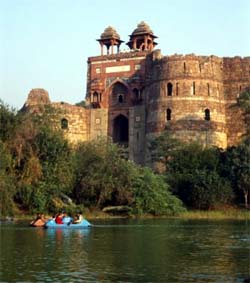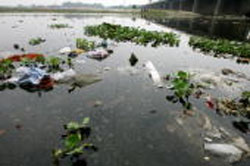Apr 23, 2024
Apr 23, 2024
Here lies the catch. The ground water resource is like a bank balance. If deposits are not made then one is liable to go bankrupt. The south Delhi block is already bankrupt because ground water is being mined there. In other words the quantity of water being extracted from the aquifers is not being replenished. Delhi is a city with a past. It I said that Delhi is named after Dhilu, a king of Mauryan dynasty, who reigned during the first century BC. That is why the names, Delhi, Delhi and Dilli. Earliest reference of settlement in Delhi is seen in the Mahabharata i.e. around 1400BC. The city was then called Indraprastha. Delhi witnessed a major construction activity during the Mughal Empire between 1526 and 1712 AD. With the arrival of the British need for further expansion was felt. Thus under the guidance of Edwin Lutyen, New Delhi was built during 1912 to 1929.
Delhi is a city with a past. It I said that Delhi is named after Dhilu, a king of Mauryan dynasty, who reigned during the first century BC. That is why the names, Delhi, Delhi and Dilli. Earliest reference of settlement in Delhi is seen in the Mahabharata i.e. around 1400BC. The city was then called Indraprastha. Delhi witnessed a major construction activity during the Mughal Empire between 1526 and 1712 AD. With the arrival of the British need for further expansion was felt. Thus under the guidance of Edwin Lutyen, New Delhi was built during 1912 to 1929.
The post Independence era has seen Delhi bloom into a metro. The Capital is bursting with population, roads are choked with automobiles and taps run dry in Delhi. The population of Delhi has shown a phenomenal growth rate. From 1981 to 1991 it grew at a rate of 1.63% and the population soared to 9,421,000. The present population of Delhi including the floating population is estimated to be plus 16 million.
Seeing the hustle and bustle of Delhi, a nine year old school girl from Uttarakhand on her maiden trip blurted, 'this place suffers from people's pollution!'
When there are people they need water.
In the lingua of the environmentalists each habitation has a carrying capacity. The population pressure at places is so great that some cities exceed their carrying capacity. Beijing and Shanghai in China and Delhi and Chennai in India are two such cities that have in the matter of need for water have swollen beyond their carrying capacity. These cities are no small towns they are the mega-cities of the world.
With our country on the threshold of being classified amongst one of the developed nations and with taps running dry in its capital sounds alarming. There is amongst the scientific communities' lots of brain storming to find a solution for the gargantuan problem.
Vikram Soni of the National Physical Laboratory, New Delhi has come forward with a paper in the Current Science, suggesting ways to tackle the problem. For the above mentioned mega-cities of the developing world it is no longer a question of importing an essential resource like water, the water is just not there, says Soni. Some of the developed mega-cities have developed forests in the vicinity. For example, New York gets its water supply from 150 km away Catskills forest. Our capital is surrounded by forests of concrete for long distances. We can not even imagine that kind of arrangement as at New York.
Delhi's demand of drinking water is met through two sources. Surface water available through river and canals is 1150.80 million cubic meters (MCM) per annum. This quantity is not enough to meet the ever increasing demand of nearly 16 million people. Therefore another 252 MCM groundwater is extracted from the available resource of 291.54 MCM.
 Apart from the availability of drinking water yet another serious problem plagues the metro's drinking water supply is the pollution of water. Surface water (Yamuna) has been made a shit canal. Lesser said the better about the Yamuna water in Delhi. A study conducted jointly by the Ministry of Environment and Central Ground Water Board presents a bleak picture.
Apart from the availability of drinking water yet another serious problem plagues the metro's drinking water supply is the pollution of water. Surface water (Yamuna) has been made a shit canal. Lesser said the better about the Yamuna water in Delhi. A study conducted jointly by the Ministry of Environment and Central Ground Water Board presents a bleak picture.
Pollution of the river is anthropogenic says the report. On an average 2000 million liter (ML) sewage is generated by the Delhiites every day. Unfortunate part is that the installed capacity of the sewage treatment plants is only 1270 ML per day. Therefore, around 800 ML sewage of Delhi is allowed freely to flow in to Yamuna River.
The flow of the River is regulated through a barrage. Thus in the lean period, the River flow is sluggish. All the muck draining in to the river settles in the river bed. During rains there is a sudden onslaught of water as the weir is opened to discharge excess water. This causes upwelling currents in the River and all the muck which usually remains settled at the bottom flows out and quite a bit of it is deposited on the banks. Common sense says that the river banks in an alluvial terrain are sandy and porous. Therefore the sewage material dissolved in rainwater finds its way to the aquifer.
In addition Delhi produces 6000 tons of urban and industrial waste everyday. This is dumped regularly in the unlined landfills at Gazipur, Balsawa, Hastsal and behind Tughlakabad Fort. During rains this waste also finds its way to Delhi's aquifers.
Delhi is notorious amongst foreign tourists for 'Delhi Belly'. With the aquifers recharged with urban sewer and urban wastes stomach infections are galore. The type of the pollutants and their affects on the residents in the six blocks of Delhi are acquiring notoriety. Water samples from City, Shahadra and Najafgarh blocks of Delhi yielded much higher quantities of Coliform and fecal Coliform bacteria. It is reported that 57.99% samples from these areas have these stinking bacteria in much higher quantities. Presence of high content of coliform and fecal coliform bacteria in groundwater is absolutely due to anthropogenic activity.
Yet another problem that has started to plague the tube-wells is salinity. This is more common in and around areas of the Ridge. It is interesting to note that in nearby Gurgaon, in a village Akberpur, the villagers spread water from the well in shallow tanks. Water evaporates and leaves a layer of salt. The practice of making salt in the village has been going on since decades. It is also worth knowing that there are layers of rock salt in between the sedimentary rocks in parts of Rajasthan, close to Akberpur. Often there are sub-surface ruptures and salt escapes to aquifers. Fortunately these layers are at a depth, thus commonly such escapades are not there. But it will not be surprising if deeper aquifers of the Ridge area too have such layers and because of excess withdrawal salt is escaping to ground water! The problem needs attention of the geo-hydrologists.
Development without studying the carrying capacity of the land is what ails Delhi. The sustainable carrying capacity of Delhi is about eight million says Vikram Soni, whereas the present population is more than double! Water is being imported to Delhi from Beas and Ganga Rivers. These rivers are the backbone of the neighboring agrarian states. Thus in order to quench the thirst of overcrowded Delhi the agriculture of the states suffers. It can lead to a strife any time now or in the future.
Vikram has tried to evaluate the available underground water resources of Delhi and ways to preserve them. River Yamuna and the Ridge (a part of the Aravalli range) according to Vikram are the two major natural features of Delhi. These two were the centre of attraction for the early settlers in Delhi. Both the features have water in them, either at the surface or at depth.
The two billion old rocks of the Ridge have enough joints and fissures to permit percolation of rainwater to depths. This is the oldest sculpted natural heritage for Delhi and recharges 80% of rainwater. The Ridge Needs to be preserved.
Hypothetically as per the calculation of Vikram taking the recharge potential as 60% only and an area of 150 sq km of the Ridge and average annual rainfall as 60 cm, he postulates an annual recharge potential of the Ridge at 60 MCM. That is water worth Rs.11,000 crores per annum!
The other potential source of water for Delhi that is Yamuna floodplain he says has a recharge value of Rs.10,000 crores per annum.
In addition he enlists deep aquifers of Delhi, which he rightly says should be used only in case of an emergency. Unfortunately some of these are already being used by developers in neighboring Gurgaon he says.
Our ancestors had rightly chosen Delhi as a Capital and had left a rich legacy. However, like an unworthy son we have been squandering the balance of water available. It needs a political and social will to set the Delhi on path of sustainable development. Otherwise the future generations might read about Delhi only in the books of history!
21-Oct-2007
More by : V. K. Joshi (Bijji)